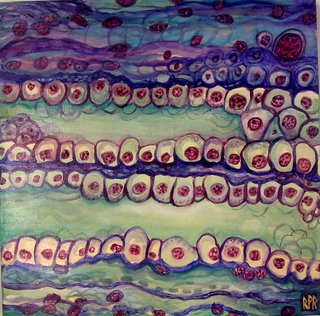Tools for learning to Love
The self-inquiry process is not a self-indulgent act, as some misunderstanding souls may perceive. Self-inquiry, if engaged in as a reflective practice of becoming more human, facilitates true transformation that moves the individual into a more grounded, relational focus. It produces a reunion between self AND others. Self-inquiry towards inner transformation accomplishes this in two related ways:
First, becoming conscious requires the complete honesty to accept and take responsibility for all parts of ones self. The difficulty comes when we resist this act, lessen its role in teaching us, and try to cover it through the mask of "good behavior" and acts of Kindness to others. This denial of the truth of darkness only perpetuates it, and lodges it deeper within. We need the grace of God to give us courage to taste the bitterness in our hearts, to look at it square in the face, and then chose to move through it. We are commanded to love others as we love ourselves, but what happens when we aren't able to do the later? What does it mean to love,accept, and cherish the child of God within? Many Christians are under the belief that the truest nature of the heart is sinful, not willing to recognize how this inner belief divides themselves within. Just as a house divided can not stand, our faith and life "lived for God" will not shine authentically until we get real within our hearts. A view of Self as sinner seems to go against our identity rooted in the triumph over death and the gift of the resurrection of new life in Christ. True Life means we are actively engaged in growing into the lIkeness of Christ in this lifetime. Self as intimately intertwined to our Divine nature (grafted into the Vine) removes and lessens the effects of human limitations that disconnect us from fully being open, giving, and loving.
This brings me to the second aspect of the self-inquiry process. As created beings within God's creation, we are ecologically interconnected to the world around us. This means we are made to relate to other human beings in profound and nourishing ways. It would seem that self-inquiry as a process of becoming honestly open, allows us to love and be loved in ways we never have experienced before. As the self becomes more grounded in our Divine identity in Christ, we first learn to give and receive love within. This alone, empowers us to socially interact beyond ourselves in pure love. Ultimately, the power of the self-inquiry process is about reunion back to the Divine, which becomes manifested through the quality of union to the creatures in the universe.
First, becoming conscious requires the complete honesty to accept and take responsibility for all parts of ones self. The difficulty comes when we resist this act, lessen its role in teaching us, and try to cover it through the mask of "good behavior" and acts of Kindness to others. This denial of the truth of darkness only perpetuates it, and lodges it deeper within. We need the grace of God to give us courage to taste the bitterness in our hearts, to look at it square in the face, and then chose to move through it. We are commanded to love others as we love ourselves, but what happens when we aren't able to do the later? What does it mean to love,accept, and cherish the child of God within? Many Christians are under the belief that the truest nature of the heart is sinful, not willing to recognize how this inner belief divides themselves within. Just as a house divided can not stand, our faith and life "lived for God" will not shine authentically until we get real within our hearts. A view of Self as sinner seems to go against our identity rooted in the triumph over death and the gift of the resurrection of new life in Christ. True Life means we are actively engaged in growing into the lIkeness of Christ in this lifetime. Self as intimately intertwined to our Divine nature (grafted into the Vine) removes and lessens the effects of human limitations that disconnect us from fully being open, giving, and loving.
This brings me to the second aspect of the self-inquiry process. As created beings within God's creation, we are ecologically interconnected to the world around us. This means we are made to relate to other human beings in profound and nourishing ways. It would seem that self-inquiry as a process of becoming honestly open, allows us to love and be loved in ways we never have experienced before. As the self becomes more grounded in our Divine identity in Christ, we first learn to give and receive love within. This alone, empowers us to socially interact beyond ourselves in pure love. Ultimately, the power of the self-inquiry process is about reunion back to the Divine, which becomes manifested through the quality of union to the creatures in the universe.



